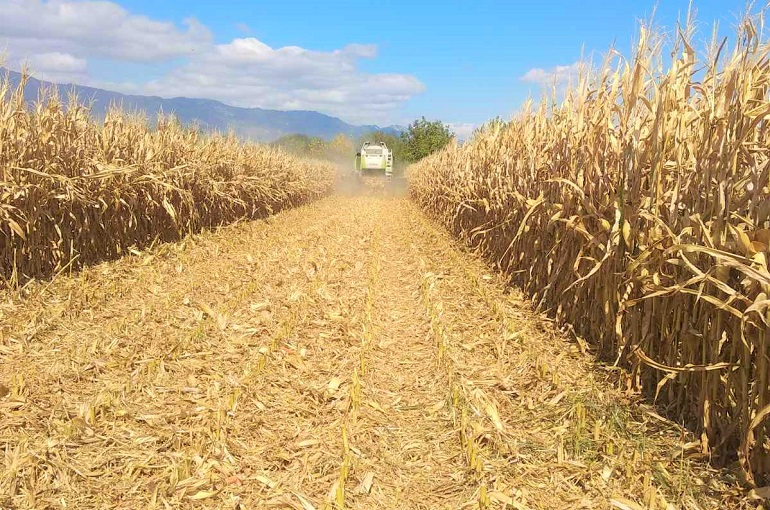Calculating Bags per Hectare: Maize, also known as corn, is a staple crop in Zambia, contributing significantly to food security and the economy. Understanding the optimal planting density and yield per hectare is crucial for farmers like those at Nitumezi Farms to maximize their production and ultimately their profits. One common metric used by farmers to measure maize yield is the number of bags produced per hectare. In this article, we will explore how to calculate the number of bags of maize per hectare in Zambia, using Nitumezi Farms as a practical example.
Calculating Bags per Hectare in Zambia (Maximizing Maize Yield)
Calculating Bags per Hectare: To calculate the number of bags of maize per hectare, several factors need to be considered, including seed spacing, plant population, and average yield per plant. Let’s break down the calculation step by step:
- Determine Seed Spacing: Seed spacing refers to the distance between each maize seed when planting. In Zambia, a common seed spacing for maize is around 25-30 cm between rows and 10-15 cm between seeds within a row. This spacing allows for optimal growth and resource utilization by the plants.
- Calculate Plant Population: Plant population is the number of maize plants per unit area, typically measured in plants per hectare (pph). To calculate plant population, use the formula: Plant Population (pph) = [(10,000 ÷ Seed Spacing (cm)) x (10,000 ÷ Seed Spacing (cm))] ÷ 2
- Determine Average Yield per Plant: Average yield per plant varies depending on factors such as soil fertility, weather conditions, and crop management practices. However, in Zambia, a common yield per plant can range from 1 to 3 ears of maize, with each ear containing an average of 300-400 kernels.
- Calculate Total Yield per Hectare: Total Yield per Hectare (in kg) = Plant Population (pph) x Average Yield per Plant (kg/ear) x Number of Ears per Hectare
- Convert Total Yield to Bags: To convert the total yield from kilograms to bags, divide the total yield by the weight of a bag of maize. In Zambia, bags of maize commonly weigh 50 kg each.
How many bags of maize per hectare in Zambia
Practical Example: Let’s consider your farm, where you planted 2 hectares of maize using 50 kg of seeds. Assuming a seed spacing of 25 cm between rows and 10 cm between seeds within a row, let’s calculate the number of bags of maize per hectare:
- Seed Spacing: Row spacing = 25 cm Seed spacing within the row = 10 cm
- Calculate Plant Population: Plant Population (pph) = [(10,000 ÷ 25) x (10,000 ÷ 10)] ÷ 2 ≈ [(400 x 1,000) ÷ 250] ÷ 2 ≈ (400,000 ÷ 250) ÷ 2 ≈ 1,600 ÷ 2 ≈ 800 pph
- Assume an Average Yield per Plant: Let’s assume an average yield per plant of 2 ears, with each ear containing 350 kernels.
- Calculate Total Yield per Hectare: Total Yield per Hectare (in kg) = 800 pph x (2 ears/plant x 0.35 kg/ear) x 20,000 (ears per hectare) ≈ 800 x 1.4 x 20,000 ≈ 22,400,000 g ≈ 22,400 kg
- Convert Total Yield to Bags: Number of Bags = Total Yield (kg) ÷ Weight per Bag (kg) = 22,400 kg ÷ 50 kg = 448 bags
Conclusion: In conclusion, by following these steps, we can determine the number of bags of maize per hectare in Zambia. Proper planning and management practices, including seed spacing, plant population, and yield estimation, are essential for achieving optimal maize production.
By understanding these calculations, farmers can make informed decisions to maximize their yield and ultimately improve food security and livelihoods in Zambia.

How many bags of maize can an hectare produce
Thank you very much. How can I get through for more insights.
Good morning, the spacing of 25-30cm between ralls . Is it not too narrow for animal draft ploughing?
Because we were generally told of 75cm.
Why are we dividing the pph by 2.
In Zambia, when calculating bags of fertilizer per hectare, we divide the phosphorus (P₂O₅) or potassium (K₂O) rate by 2 because fertilizer labels use the oxide forms of these nutrients. To estimate the actual elemental phosphorus (P) or potassium (K) being applied, dividing by 2 gives a closer approximation of the usable nutrient amount.
It’s a miscalculation. This estimate gives 22 tons per hectare. Yet the national average yield is 2.3 tons per hectare. Redo the calculations
Powerdul
we thank you for that educational program